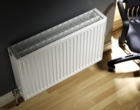Radiators meet renewable heating

The lower flow temperatures associated with heating systems using renewable energy are not incompatible with radiators, as Chris Harvey explains.
There’s something of an urban myth spreading in the heating sector that the only sensible response to emitting heat from a renewable heating system is underfloor heating. It is certainly one response but far from the only one. Radiators, particularly the latest-technology radiators, are not only adequate but they also offer a cost-effective and highly efficient response to the need for heat from renewables — in both domestic and commercial environments.
Whilst the current economic climate has put something of a damper on the mass move to renewables, renewable systems are becoming gradually more common. In particular, developers of new homes, local authorities and homeowners are considering renewable energy sources as their preferred energy source to heat buildings and to do their bit for the environment as they aim to contribute towards a low-carbon economy.
The most common renewable-heating methods are air-source or ground-source heat pumps and solar thermal systems — all of which can produce effective and energy-efficient room heating.
Heating systems driven by renewable energy will typically operate at a ∆T of 30 K (difference between the water flow and return temperature) because of the lower temperature generated by the renewable-heat source compared to conventional methods such as boiler-driven systems operating with a ∆T of 50 K.
The principal factor determining the heat output is the difference between the ambient and system temperature. Lower system temperatures require heat emitters with larger surface areas to provide the output required to provide a comfortable room temperature. This requirement doesn’t necessarily mean a requirement for huge expanses of radiator in a room. With modern technology, there are other ways of providing the surface areas required.
Two excellent ways to achieve these larger surface areas come in the form of either a vertical or triple-panel radiator.
Vertical radiators partner renewable-heating systems perfectly as they offer the larger surface area required by the low system temperatures, contributing significantly to a reduction in energy usage and lower heating bills. They also free up valuable horizontal space. It is important that radiators are designed to be used vertically so that they disperses heat effectively and avoid cold spots on the radiator.

Stelrad’s vertical radiators for example come with six connections to give installers a range of installation options. Features such as the two centre connections (centre tap) at the bottom of the radiator, contribute to of ease of installation. Stelrad’s vertical radiators area available as standard panel radiators, flat fronted Planar, Compact and Style models.
Another solution for renewable heating systems is the triple-panel radiator. Single- and double-panel radiators are common within the UK, but triple panel radiators with three panels and three fins are new to the UK marketplace, although they are quite common in mainland Europe because of the lower system temperatures often employed there.
Commonsense tells us that it is the heat-output requirement that determines the size of a radiator. By doubling up or tripling up on the number of panels, it’s possible to achieve higher heat levels from shorter radiators. For example, a shorter Stelrad K3 triple-panel radiator would benefit from a space point of view when compared to a longer K2. A K3 600 mm high and 800 mm long radiator produces a similar amount of heat to a K2 600 mm high and 1200 mm long showing just how effective a triple-panel radiator is for delivering the required heat output.
The benefits of radiators being installed on renewable systems are many. First, no maintenance is required — assuming the heating system has been properly installed, including being flushed and inhibited as required by Part L of Building Regulations. And of course being on the wall, the heat they emit is not affected by coverings of any type, compared to underfloor where the heat emitted can vary depending on the floor coverings utilised.
Radiators are the heat emitter of choice for the vast majority of traditional wet heating systems — and will remain so, whether new systems are served by a boiler or renewable heating. In particular, Stelrad’s steel panel radiators, horizontal or vertical, are available from stock..
Chris Harvey is product manager with Stelrad Radiators








